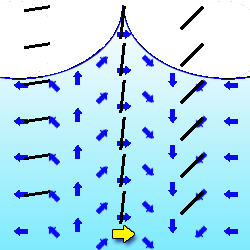User:DM8954/Wave Propulsion Louvers
Description
Using louvers to convert multi-directional wave energy on the open ocean and convert it into a directional force for low-speed propulsion and station keeping.
Detail
Louvers[1], generally speaking, are horizontal slats which are angled to let in air and light while also keeping out rain, noise, and direct sunlight. The same concept has been applied on a smaller scale, with adjustable window blinds. Louvers have also been adapted into use in small building exhaust vents. When air moves from the inside to the outside of a building, through these louvered vent covers, the louvers open easily to allow the undesirable air to low through. Air moving in the other direction (wind) forces the louvers to close, preventing outside air from entering.
I would like to submit the possibility of using a system of independent, unidirectional louvers to block water moving in a single direction within a wave in order to transfer part of that kinetic energy to a watercraft or seastead for the purposes of low-speed propulsion or station keeping.
Particle motion within a surface wave is essentially circular, so that as a wave moves through the water individual particles move forward with the wave, down, back, up, and forward again to their original position. By selectively resisting and permitting the flow of these particles, a directional force can be extracted and applied to any structure this device is connected to. Further, by using multiple devices spaced at regular intervals, energy can be extracted from different portions of a wave so that the overall forces collected add up, roughly, to a single continuous force.
The image above shows how the forces within a wave would interact with the louver system. I tried to keep the animation slow enough that people could follow the forces, despite their complexity. It helps to focus on a single set of louvers to get a better understanding of what's going on in the bigger picture. You'll notice that the yellow arrows (representing forward motion/force) don't always appear as soon as a louver is closed. If you watch closely, you'll see that it is usually because the water is moving down, which would be enough to close the louvers but not to add any forces to the system.
Control
It will be necessary to be able to control this system in 2 primary ways:
Direction - A system comprised of multiple louver panels would need to be able to rotate to face the desired direction of travel. This could be handled either by turning each panel separately, in small pod-groups, or as an entire system.
Speed - The louver system could be turned on and off by forcibly holding the louvers open to allow water to move freely in either direction. With a multiple panel system, turning some off while leaving others on would allow for a variation in the speed of the overall system in relation to the water.
Station Keeping
Surface waves are driven primarily by the wind. This means that a majority of the waves a craft experiences will run in the same general direction as the wind. By turning this system against the wind, it could capture energy more efficiently than any other direction (except with the wind) and primarily counteract the force of the wind on the exposed portions of the vessel in question. Since seawater is much more dense than air, it takes less area to capture the same amount of energy, compared with sails, or in this case aerodynamic drag on the structure.
Potential Negatives
This system requires a material that is both durable under repeated impact forces of the water slamming them closed against the frame and of a suitable material that won't corrode too quickly in seawater. This seems to be a tall order, especially if trying to avoid high maintenance costs.
This system could also be somewhat noisy if not properly designed. The motion of the sea would cause nearly continuous impacts from the various louver modules, which would need some form of sound dampening. Even with such padding, the underwater sounds and/or vibrations could drive sea life away.
While this system could potentially allow for travel in any direction using little or no outside energy, the top speed achievable will always be less than the speed of the waves themselves. This makes it ideal for station keeping but impractical for primary propulsion.
